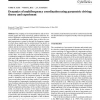Free Online Productivity Tools
i2Speak
i2Symbol
i2OCR
iTex2Img
iWeb2Print
iWeb2Shot
i2Type
iPdf2Split
iPdf2Merge
i2Bopomofo
i2Arabic
i2Style
i2Image
i2PDF
iLatex2Rtf
Sci2ools
BC
2005
2005
Dynamics of multifrequency coordination using parametric driving: theory and experiment
Abstract The coupling of movement behavior and environmental signals has been extensively studied within the domain of rhythmic coordination tasks. However, in contrast to most traditional coordination studies, here we drive the coupled sensorimotor system far beyond the frequency regime in which these signals may be synchronized. Our goal is to identify the properties of the coupling between the human subject and the environment. Earlier studies have shown that the environmental signal may be parametrically coupled to the effectors. A necessary feature of parametrically driven oscillators is the existence of stable 1:1 and 1:2 coordination modes. Here, we test this prediction experimentally using a coordination paradigm in which subjects were asked to coincide peak finger flexion with an auditory metronome beat. The rate of the metronome was increased in steps of 0.5 Hz from 2.5 Hz to 12 Hz. It was observed that the subjects shifted involuntarily from a 1:1 to a 1:2 coordination mode ...
| Added | 15 Dec 2010 |
| Updated | 15 Dec 2010 |
| Type | Journal |
| Year | 2005 |
| Where | BC |
| Authors | Collins G. Assisi, Viktor K. Jirsa, J. A. Scott Kelso |
Comments (0)

